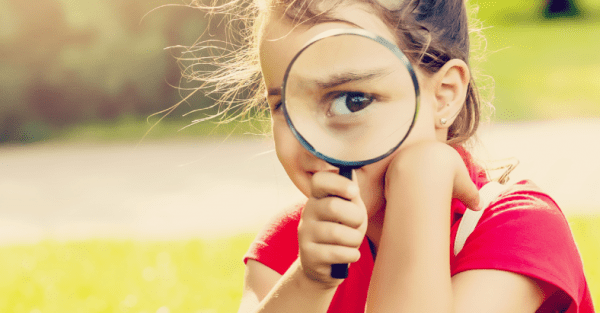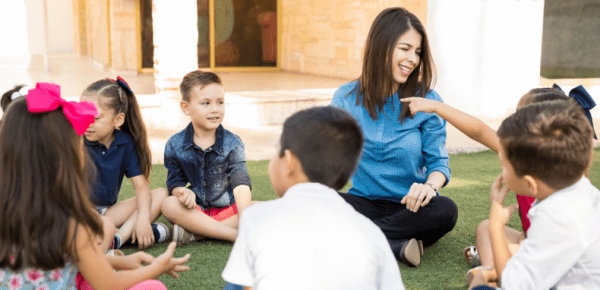Executive function – looking through a new lens
Executive function – looking through a new lens by Desley Jones
Varied perspectives on using an executive functioning lens to understand and extend their work with young children.
By Desley Jones who is working within Community Kindergartens Affiliated with Lady Gowrie Queensland
A group of children are heading inside to the carpet after playing in the outdoors. I have asked them to “please sit on the edge of the carpet beside someone who you didn’t play with outside.” So…what is significant about this request? Fundamentally, it is acknowledging our program’s focus on building positive relationships with, and between, children. I want the children to build confidence in being with, and interacting with, a range of individuals, not just those they choose to play with. But just as importantly, this request will provide practice for the children (and allow me to observe) their executive function abilities.
Will they:
- remember what they were asked to do or will they sit anywhere – perhaps in front of my chair rather than on the edge?
- resist the urge to sit beside someone they played with, someone they know well?
- be able to shift their attention to the wider group of children and be able to choose another child to sit near?
“Executive function is an umbrella term used to refer to a variety of interdependent skills that are necessary for purposeful, goal directed activity from learning to hold a crayon to engaging in more complex social play” (Shonkoff & Phillips, 2000, p116).
As early childhood teachers and educators, executive function affords us another lens through which to consider the behaviour, development and learning of the children with whom we work. Through this lens, we may find that we observe, respond and plan for our children in new ways.
Executive function is generally considered to consist of the following three elements:
- Working memory – the capacity to hold and manipulate information in our heads over short periods of time.
- Inhibitory control – the skill we use to master and filter our thoughts and impulses so we can resist temptations, distractions, and habits and to pause and think before we act.
- Cognitive or mental flexibility – the capacity to nimbly switch gears and adjust to changed demands, priorities or perspectives. It enables us to apply different rules in different settings. (Centre for the Developing Child, 2011).
From these definitions, it may be obvious that executive function underlies human behaviour across the lifespan and in all contexts. As I write this paper, I am using my working memory to keep in mind what I am writing about. My inhibitory control means that I am resisting the urge to procrastinate, to turn on the TV, put the laptop away and ‘zone out’; and my cognitive flexibility is also allowing me to consider how to incorporate the points I think are paramount to consider – that executive function requires opportunities for practice and scaffolding in the context of secure relationships to fully develop, or that it offers a significant link between the play based, social-emotional development of early years education to the more academic focus of formal schooling (Centre for the Developing Child, 2011).
Executive function impacts on both children’s social interactions and their engagement in learning experiences. Children with poorly developed or underdeveloped executive function will have trouble recalling instructions or holding information in mind for short periods of time, they will be restless and likely to respond inappropriately when things don’t go their way. They may find it hard to wait in turn, to keep their hands away from others or to remain focussed on the task they have been given. Their abilities to fully engage in experiences is limited as they will struggle to adapt to changes or to consider more than one piece of information at a time (e.g. considering two clues at once as they guess what’s in the bag). Likewise their ability to consider different solutions to problems or their ability to incorporate another child’s ideas in play may be compromised.
“Executive function skills are crucial building blocks for the early development of both cognitive and social capacities.” (Centre for the Developing Child, 2011, p3)
As such, executive function skills provide an important link between the traditional focus of early childhood education on social/emotional development and the more formalised academic learning of school, thus providing a new way for teachers and educators to communicate with schools and parents about the importance of early education curriculum in relation to their transition to Prep. Blair and Raver (2015) contend that self-regulation (including both the cognitive regulation of executive function, and social/emotional regulation) provides an appropriate framework for considering school readiness.
How can we, as early childhood teachers and educators support the development of children’s executive function? Most fundamentally is the need to base our teaching/ learning programs within a context of positive and supportive relationships with, and between, children (Centre for the Developing Child, 2011; Nagel, 2012; Shonkoff & Phillips, 2000). According to Blair (2003, p5), “Learning occurs within relationships. Early learning environments in which teachers are attuned to temperamental differences among children may help to provide a comprehensive basis for the development of skills important for learning.”
Executive function – looking through a new lens – continued
Such “growth-promoting environments provide substantial ‘scaffolding’ to help young children practice emerging skills before they are expected to perform them on their own.” (Centre for the Developing Child, 2011, p6) Knowing children well means that teachers are able to provide the individualised scaffolding required for these developing skills; when more help is required and when it is time to withdraw assistance.
“When information is too complex and environments are stressful, executive functions shut down; when information is too simple and environments are uninteresting, executive functions are not called on. This…is the basis for the Vygotskian notion of the zone of proximal development.” (Blair & Raver, 2015, p718)
Children’s social pretend play is considered to be an important practice ground for developing executive function skills (Centre for the Developing Child, 2011; Nagel, 2012). In this play, children test for themselves the skills that adults have been scaffolding. They have to generate an idea for play, communicate it to other players, resolve issues in socially appropriate ways if the play is to continue, recall what is happening in the play and adapt to new ideas or scripts inserted into the play.
Executive function can be seen to be in operation throughout the day. Because these skills underpin all aspects of our life, it is possible to both observe and plan for them across the early childhood curriculum.
An experience as commonplace as drawing has the potential to engage children’s executive function skills. As they draw, children focus attention on particular aspects of an experience they consider important, inhibiting distractions. Cognitive flexibility is demonstrated as the drawing and the children’s thinking transforms and as they shift back and forth from their mental thinking to the visual representation of the drawing. As children’s use of drawing becomes more complex, they recall previous ideas and thinking, making use of working memory (Sonter & Jones, 2018).
If we consider routine and transition times in an early education program, we can again see executive functions in practice in the basic experiences and games that might be played: children recall instructions (working memory), resist the impulse to deviate from what is required (inhibitory control) and respond to unexpected developments e.g. if the morning tea mats have been placed in a different location (cognitive flexibility).
Understanding executive function and its role in human development is important for early childhood teachers and educators to explore. Its potential lies in providing us a much richer way to understand children’s learning and development, to recognise how we can appropriately scaffold such foundational development, and to communicate the value of our early childhood programs to the broader community.
This article has been written by Desley Jones on behalf of LEX (Leading Executive Functioning) – a group of early childhood practitioners (Sue Southey, Leanne Hunter, Lisa Sonter and Desley Jones) who are working within Community Kindergartens Affiliated with Lady Gowrie Qld and share varied perspectives on using an executive functioning lens to understand and extend their work with young children.
Reference List
Blair, C. (2003). Self-Regulation and School Readiness. ERIC Clearinghouse on Elementary and Early Childhood Education. Retrieved from https:// files.eric.ed.gov/fulltext/ED477640.pdf
Blair, C., & Raver, C.C. (2015). School Readiness and Self-regulation: A developmental psychobiological approach. Annual Review of Psychology, 66, 711-731.
Center on the Developing Child at Harvard University. (2011). Building the Brain’s “Air Traffic Control” System: How Early Experiences Shape the Development of Executive Function: Working Paper No. 11. Retrieved from www.developingchild.harvard.edu
Nagel, M.C. (2012). In the Beginning: The brain, early development and learning. Camberwell, Aust: ACER Press.
Shonkoff, J.P., & Phillips, D.A. (Eds.). (2000). From Neurons to Neighbourhoods: The science of early child development. Washington, DC: National Academy Press.
Sonter, L.J., & Jones, D. (2018). Drawing as a Tool to Support Children’s Executive Function in Play. International Art in Early Childhood Research Journal, 1(1). Retrieved from: http://artinearlychildhood.org/ journals/2018/ARTEC_2018_Research_Journal_1_ Article_6_Sonter.pdf




